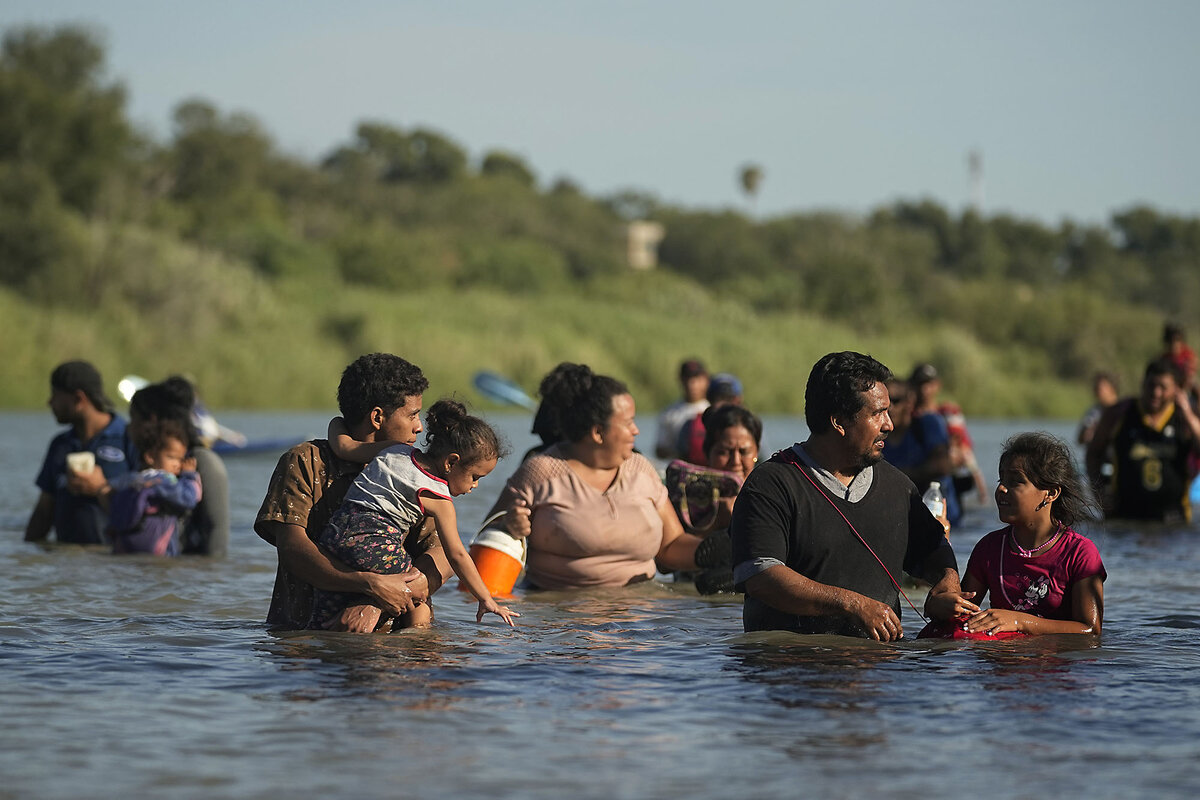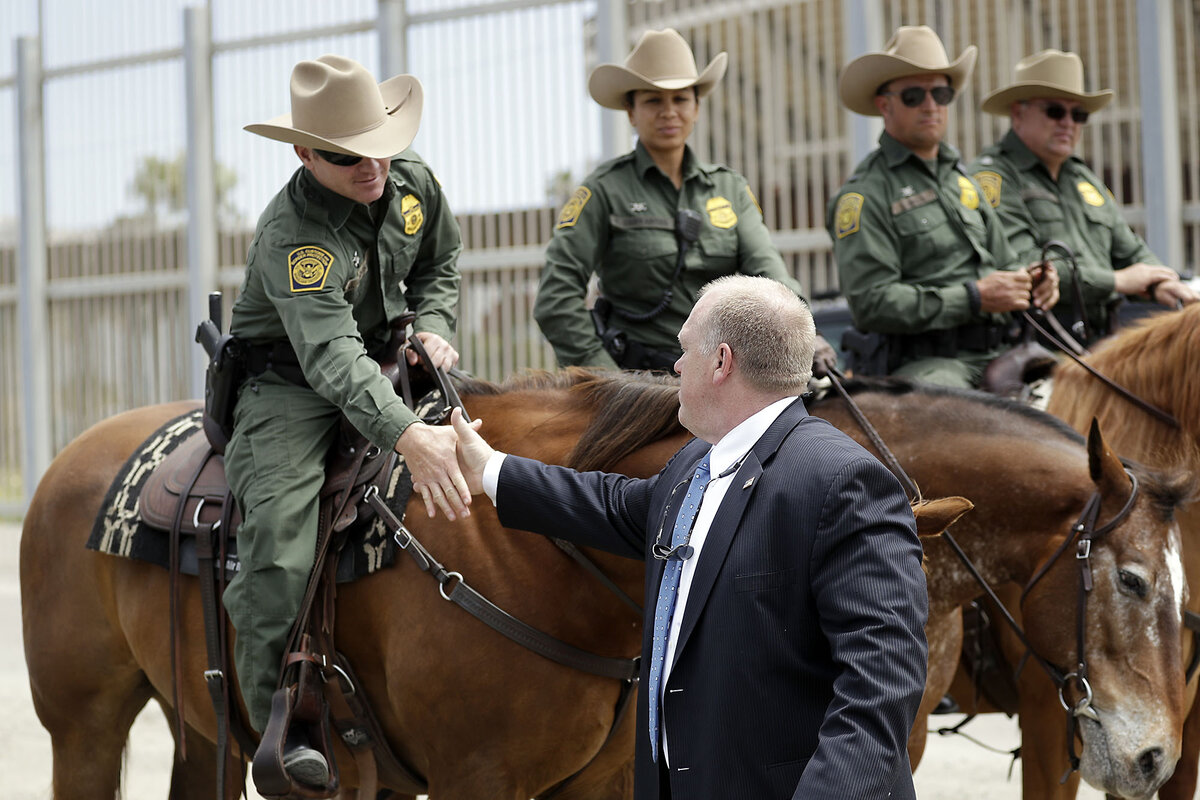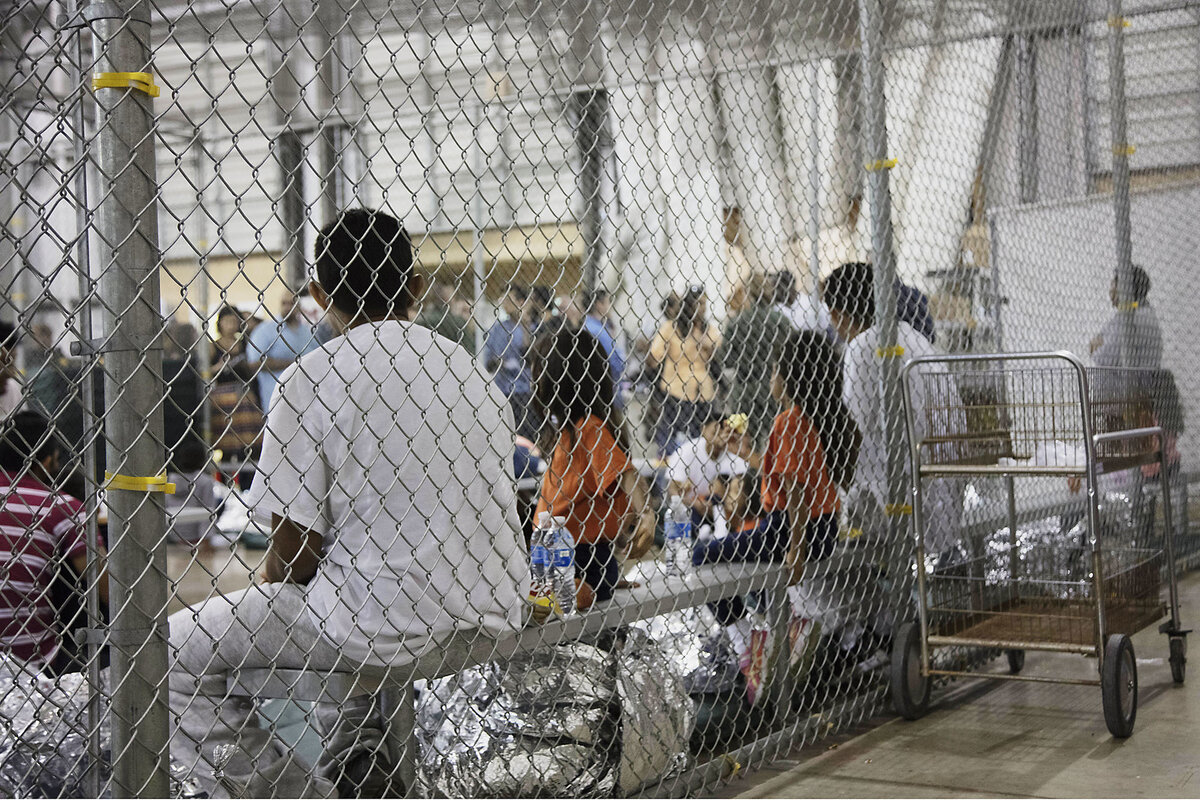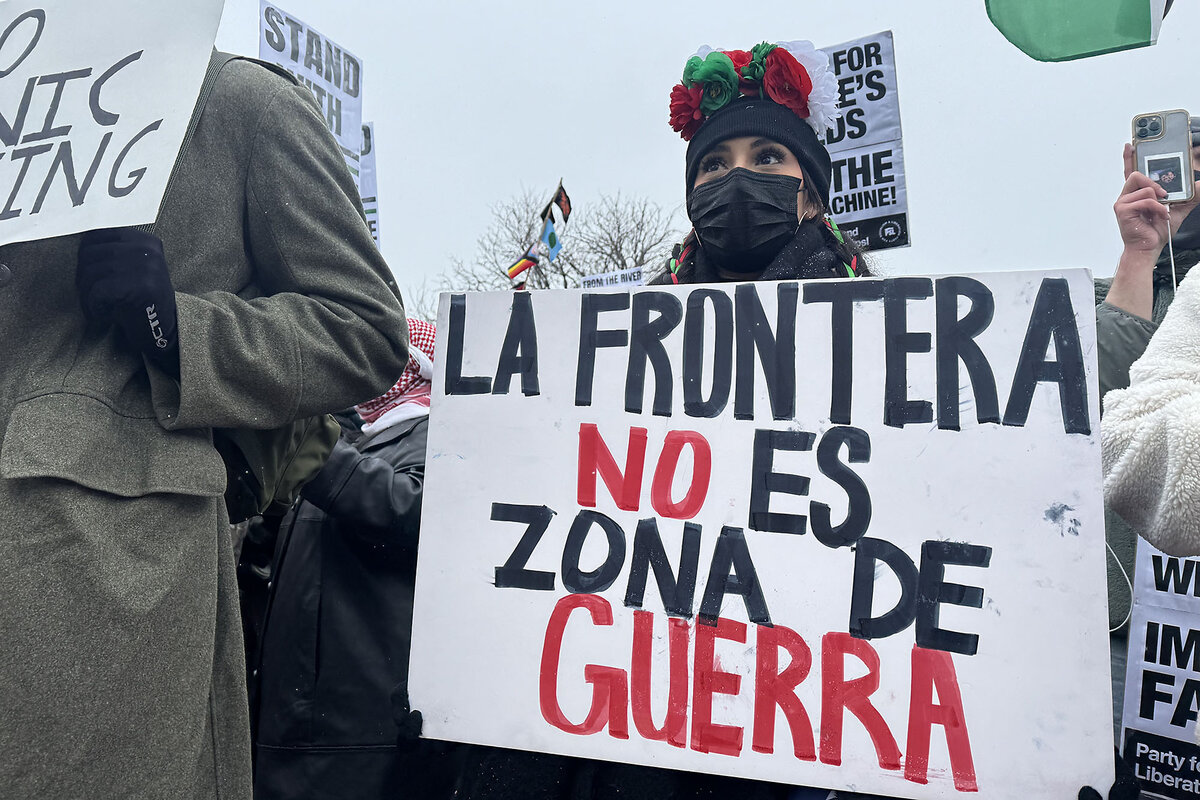He’s ‘in charge’ of mass deportations. Why Trump listens to Tom Homan.
Loading...
| Aurora, Colo.
Tom Homan, the “border czar” handpicked by President Donald Trump, has arrested, detained, and deported unauthorized immigrants since 1984. Friends call him loyal. Critics have likened him to a Nazi; he counters that the agency he once led deported real ones.
Mr. Homan is positioned to play an integral role in shaping the Trump administration’s crackdown on illegal immigration. President Trump elevated him to a top White House post and tasked him with being “in charge” of border security and deportation efforts that have already begun.
Mr. Homan’s role doesn’t require Senate confirmation, and he’ll need to work with others like Homeland Security Secretary Kristi Noem. But the president has given him strong backing. “I have no doubt he will do a fantastic, and long awaited for, job,” Mr. Trump said on Truth Social.
Why We Wrote This
President Donald Trump has tasked his new “border czar” with significant responsibilities. The next immigration chapter for the United States may well be shaped by his aggressive plans.
The border czar and the president are like-minded on illegal immigration, says Jessica Vaughan, director of policy studies at the Center for Immigration Studies. “If anything, I think Tom Homan’s understanding of this issue has informed Donald Trump’s – not the other way around.”
In philosophy, though, there appears to be a sliver of difference between the men. The president largely speaks of unauthorized immigrants as endangering the nation. Mr. Homan adds that, by crossing in illegally, they’re also endangering themselves.
Mr. Homan’s outlook, shaped over three decades, comes in part from witnessing despair at the border. The country’s next immigration chapter may well be shaped by his hard-line plans.
Why he’s focused on consequences
Mr. Homan has a pugilistic air. A fixture of conservative TV, he’ll often raise his voice. He cites immigration law, in favor of more enforcement. Sometimes he’ll curse.
“If you don’t want to help us, then just get the hell out of the way,” he says of uncooperative local politicians. And if they impede, “There will be consequences.”
He often speaks of consequences.
Not just for “sanctuary” jurisdictions and immigrants who don’t abide by laws. But also for the country, with the entry of drugs and criminals that he says the last White House left unchecked.
“The gruff exterior that you see on TV is how he is in person,” says John Fabbricatore, a former Immigration and Customs Enforcement official in Colorado who knows the border czar. “He demands excellence from the people that work for him. But he’s also very loyal.”
Mr. Homan grew up 40 miles south of Canada, in West Carthage, New York, along with six siblings. In high school, he wrestled. He describes his family as “very conservative and very Catholic,” filling the same pew each Sunday Mass.
After a stint in community college, he graduated with honors from SUNY Polytechnic Institute in 1983 with a bachelor of professional studies in criminal justice. Mr. Homan served in his town’s police force after that. His father and grandfather also served in law enforcement.
In 1984, he began working for the U.S. Border Patrol, then as a special agent. In Texas, he helped set up an undercover operation that he says ensnared 11 smuggling groups. He’d find migrants stashed in the back of stiflingly hot and crowded tractor-trailer rigs, desperate to head north.
In the sweltering Texas heat, it could be 20 or 50 degrees hotter in the back of those trucks, Mr. Homan told a newspaper in 2001. “The more they use these trucks, the greater the chance for tragedy.”
His words foretold a tragedy that would change his life.
In May 2003 in Victoria, Texas, a smuggling scheme inside a tractor trailer turned deadly in extreme heat. Nineteen unauthorized immigrants died.
Mr. Homan, then working with what is now ICE, assisted the investigation. He noticed a boy inside, around the same age as his youngest son, lying dead in his underwear. It seemed the boy’s father, also dead, had tried to embrace him in their last moments alive.
That experience “made Tom Homan who he is today,” he writes in his book “Defend the Border and Save Lives.”
For four nights, he says, he couldn’t sleep. The grim images would fuel what appears to have become his philosophy of deterrence: Remove migrants’ desire to arrive illegally in the first place. Preempt the grief.
That perspective doesn’t always consider the civil unrest and other violence driving many asylum-seekers to flee their homes, from places like Haiti and Venezuela. Still, Selene Rodriguez, a campaign director at the Texas Public Policy Foundation, says it’s incorrect to assume that being pro-border security is also anti-humanitarian.
“Everybody who comes through Mexico to get to the U.S.-Mexico border has to go through some sort of a cartel network,” she says. That exposes migrants to potential assault, rape, and murder. “No human being wants anybody to go through something like that.”
Mr. Homan says he went to therapy after witnessing the tractor trailer deaths. He continued his job, rising in the ranks.
Working under presidents from both parties
Under the Obama administration, Mr. Homan served as executive associate director for enforcement and removal operations at ICE. Then-Secretary of Homeland Security Jeh Johnson says he called on Mr. Homan as part of a core group of advisers who held varying points of view.
He was “a trusted voice,” says Secretary Johnson. While reliably pro-enforcement, Mr. Homan came to meetings “armed with facts, armed with experience and wisdom.”
During this era, Central American children and families were arriving en masse. At one point, Mr. Homan presented the idea of separating migrant families at the border, Secretary Johnson recalls. The DHS leader also recalls saying no.
Secretary Johnson visualized “trying to take a small child out of its mother’s arms,” he says. “And I just wasn’t going to do that.”
Still, the administration expanded detention for unauthorized migrant families. President Barack Obama, nicknamed the “deporter in chief,” gave Mr. Homan the country’s highest award for civil service in 2015.
After three decades, Mr. Homan retired from government in January 2017.
Then came a phone call at his retirement party. Would he consider coming back for Donald Trump?
Family separation
Mr. Homan put off retirement for a man he calls “truly a friendly, caring, and honest person,” as he writes in his 2020 book.
During the first Trump term, as acting director of ICE, Mr. Homan was an architect of one of its most controversial immigration policies.
“Kids in cages,” Democrats called it.
Mr. Homan has said he suggested the “zero tolerance” policy, which resulted in separating children from their parents at the southern border as a deterrent to illegal crossings. The result was thousands of traumatized minors and adults, immigrant advocates say. The American Civil Liberties Union helped arrange reunifications.
“Often the child comes back and the first words out of their mouth are, Mommy, Daddy, why didn’t you love me enough to keep me?” says Lee Gelernt, an ACLU attorney.
Family separation was “the worst thing” that Mr. Gelernt says he has seen in three decades of work. It’s one of several high-profile court challenges that he argued against the first Trump administration. That case ended in a court-ordered settlement agreement in 2023, barring the practice for eight years. The ACLU estimates as many as 1,000 families are still separated from their children.
Incoming officials involved in family separation the first time have expressed “really no recognition that the policy was brutal and inhumane,” says Mr. Gelernt.
Mr. Homan has said he’s “sick and tired” of hearing about family separation.
The adviser has said that ICE will look to bring back family detention in “soft-sided” tent setups. It’s unclear whether some form of family separation will evolve under the current administration.
“Families can be deported together,” he told “60 Minutes” in October.
The White House last week announced that ICE arrested 11,000 “criminals” in an 18-day period. According to a recent estimate, around 13.7 million unauthorized immigrants lived in the U.S. as of mid-2023. Along the border with Mexico, Border Patrol encounters — a proxy for illegal crossings — dropped to around 29,100 last month. That’s the lowest since May 2020.
Mr. Homan’s words – and the president’s plans – send a chilling message to many immigrants.
“I’m keeping my kids home from school, because I’m scared” of deportation, says a Venezuelan mother, bundled up against the cold at a pro-immigrant rally in Aurora, Colorado, last month. Since the summer, the city has drawn national scrutiny for crimes that officials have linked to suspected members of a Venezuelan gang, Tren de Aragua.
Mr. Homan’s words for that group? “My gang’s bigger than your gang.”
In Chicago recently, he viewed an early wave of ICE arrests. He says the agency has “got to do more.”
Part of that, in his view, involves communicating results with the American public. Mr. Homan once told The Washington Post that he started every day reading media reports about immigration. And what he read frustrated him: “People don’t understand what we do or how we do it.”
To that end, he has called for the need for weekly press briefings. Those have not yet started.
“We need to show the American people we can do this and not be inhumane about it,” he has said. “We can’t lose the faith of the American people.”
Editor's note: This story was updated Feb. 18, the same day it was published, to include newly released Department of Homeland Security data on border encounters in January.









